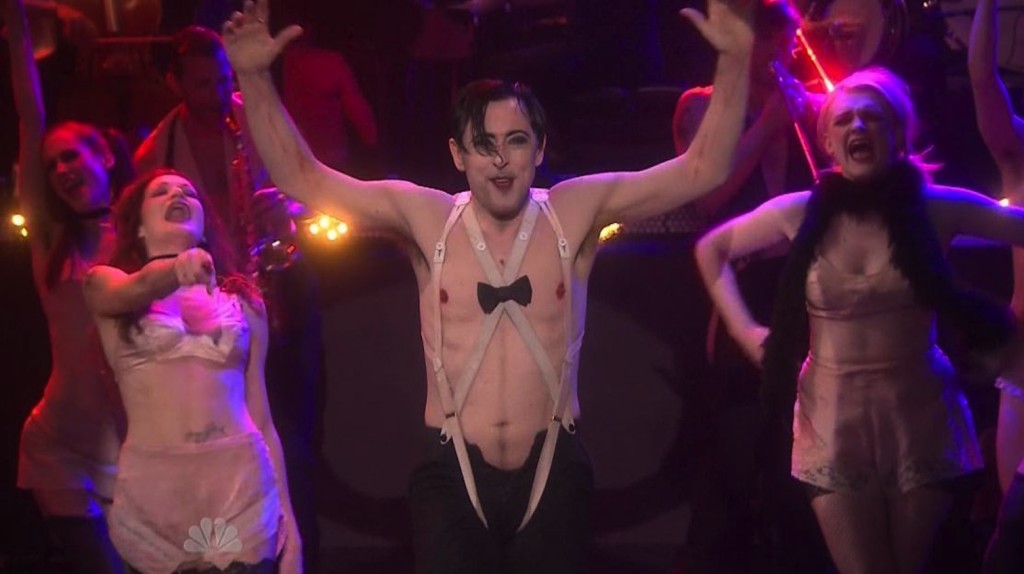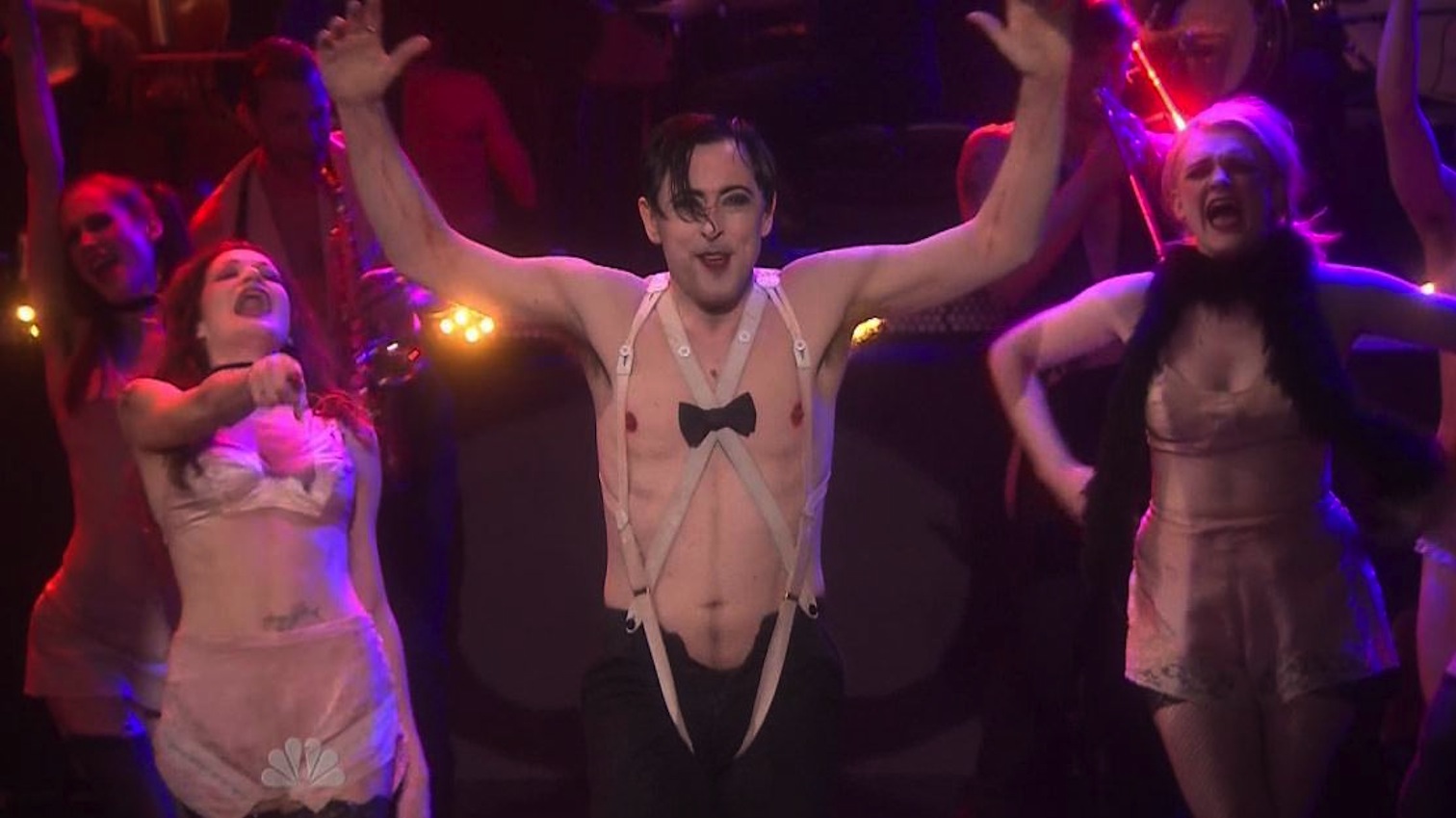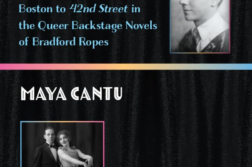Cabaret
Directed by Sam Mendes
Roundabout Theatre Company, New York City
IF YOU ONLY KNOW the musical Cabaret from the iconic Bob Fosse film starring Liza Minnelli and Michael York, then you know a version of the Christopher Isherwood “Sally Bowles” story that is no more or less true to its literary source than is the 1966 Broadway musical. In the original story, a rather callow young Englishman comes to Berlin on the eve of the Nazis’ ascension, meets an eccentric girl who sings at a seedy nightclub, moves in with her, and over time discovers the political and moral rottenness of the up-and-coming Nazi Party.
First presented on the New York stage by legendary director and producer Hal Prince with a book by Joe Masteroff and music and lyrics by John Kander and Fred Ebb, the brilliant conceit of that production was to locate the story inside a Berlin Cabaret  called the Kit Kat Klub, a name that appeared no-where in Isherwood’s story but one that conveyed the raffishness of Berlin night life in the waning days of the Weimar Republic. Outside the Cabaret’s doors, Nazis might be screaming invective at Jews or stomping on their Communist enemies, but inside the Klub, “life is beautiful!”
called the Kit Kat Klub, a name that appeared no-where in Isherwood’s story but one that conveyed the raffishness of Berlin night life in the waning days of the Weimar Republic. Outside the Cabaret’s doors, Nazis might be screaming invective at Jews or stomping on their Communist enemies, but inside the Klub, “life is beautiful!”
Fosse’s 1972 movie was credited with returning to the Isherwood stories in which the heroine was first introduced. Filmed in Berlin, this rendition of Cabaret was widely acclaimed for having captured the spirit of the English author’s highly regarded 1930s autobiographical collection The Berlin Stories. However, starting with its first and much earlier (non-musical) dramatization as I Am a Camera (1951), by English playwright John van Druten, Isherwood’s characters have been twisted like pretzels to fit dramatic needs and the temper of their times.
The current revival, co-directed by Briton Sam Mendes and American Rob Marshall, is principally the brainchild of Mendes, whose original 1993 Cabaret at London’s Donmar Warehouse was brought to New York in 1998 and was, as it had been five years earlier, a sensation. Much of that was thanks to the wickedly smarmy and decidedly eroticized performance by the young Scottish actor Alan Cumming as the Master of Ceremonies—the Kit Kat Klub’s ringmaster who’s also a foul-mouthed Greek chorus and oracle of the Nazis’ rise to power. Mendes’ other crucial contribution from 1993, the signal feature that continues today, was to turn the entire theater into the Kit Kat Klub so that much of the audience is sitting ringside at small nightclub tables and able to order drinks before show time.
Mendes retained the Broadway book by Joe Masteroff, who tweaked the script. Sally’s love interest, the American heterosexual Cliff Bradshaw in Hal Prince’s version, has over time morphed into a gay man, more or less. In 1998, John Benjamin Hickey gave Cliff a suitably intellectual posture and non-aggressive manner; he was a credible stand-in for the “Christopher Isherwood” narrator of The Berlin Stories. The current casting of Bill Heck is disconcerting. Built like a linebacker, he gives off a whiff of the all-American man, even if, in an early scene, he has a major lip-lock with one of the Kit Kat’s chorus boys. Heck is terrifically good-looking, so why complain? Well, he’s too physically imposing and self-assured to play the impish, witty Isherwood.
Alan Cumming returns triumphant; the role of Emcee fits him like a second skin. He struts and commands, teases the audience, and lures us into his lair. He is perhaps twice the age of the Kit Kat Klub boys and girls who gyrate and play instruments beside him; he slithers around suggestively as he welcomes us with “Wilkommen.” The big question mark for this production was always going to be Michelle Williams as Sally Bowles. Williams is an estimable film actress, someone who could bring reserves of vulnerability to the surface or keep them at bay. She showed this talent to brilliant effect in both Brokeback Mountain and My Week with Marilyn. Williams slides into her role and her English accent, embodying the “divine decadence” of Sally Bowles from the moment she leads the chorus girls in her first song, the naughty “Don’t Tell Mama.” When Williams sings, she throws herself into it, and the more narration that she must convey—such as “Maybe This Time” with its yearning for true love—the more she sells the song through sheer force of will. If she isn’t a great singer, she is a terrific actress who sings.
Another achievement of Prince and Masteroff was to balance the Sally–Cliff relationship with another pairing, that of Cliff’s landlady, Fräulein Schneider, and a local grocer, Herr Schultz. Bringing in two older Berliners as foils to the younger couple allows Cabaret to examine the dilemma of longtime residents—one of them (Schultz) a Jew—who cannot imagine leaving the city of their upbringing. They hang on in Berlin as best they can, Fräulein Schneider by letting rooms and Herr Schultz by running a greengrocer’s shop. Their emerging romance is threatened by Schultz’ status as a Jew. Can Fräulein Schneider withstand the social pressures arrayed against her as her own tenants and friends begin to swallow the Nazi poison pill? In the current production, Linda Emond, one of Broadway’s finest character actresses, more than delivers the vocal goods in songs like “What Would You Do?”, while Danny Burstein lends a sweet gemütlich cast to Schultz, a simple man of good heart, one who is perhaps too naïve for his own good.
The Fosse film of Cabaret dispensed with Schneider and Schultz. Instead, Fosse returned to the coupling of two younger Berliners first put together by John van Druten in his non-musical I Am a Camera. The young, fashionable, but uptight Jewish heiress Natalia Landauer and the gold-digging but ultimately decent Fritz Wendl were put together by van Druten and expanded upon by Fosse. Both characters appear in Isherwood—but without the least romance to bring them together. Berlin Stories offers numerous possibilities for some new theatrical or cinematic version of itself, and one that would barely cross the threshold of a Cabaret. Until then, we can be grateful for what Mendes and his cast have done: produced a slice of Isherwood’s Berlin in the waning hours of Weimar Germany that is sexy, insouciant, grim, and mordant, a harbinger of disasters to come.
Allen Ellenzweig, a frequent contributor to these pages, is the author of The Homoerotic Photograph.






